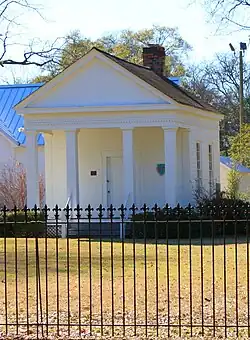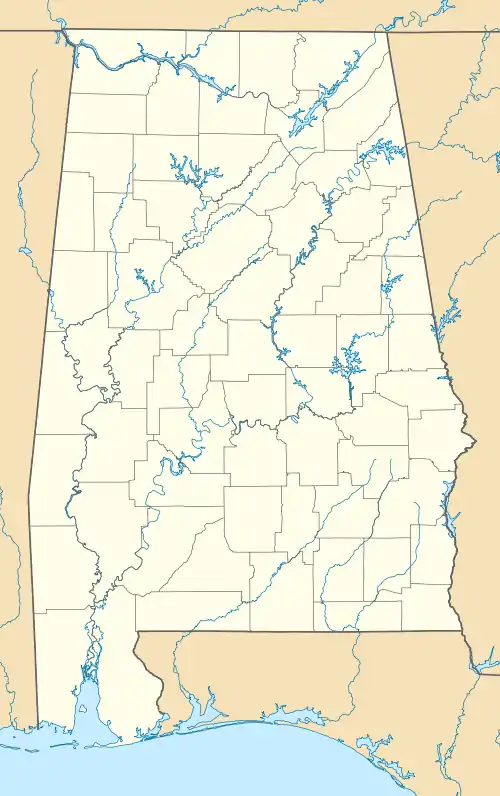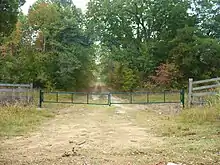Roseland Plantation | |
 The Roseland Apothecary Office, now at Sturdivant Hall | |
  | |
| Nearest city | Faunsdale, Alabama |
|---|---|
| Coordinates | 32°26′26.40″N 87°34′13.02″W / 32.4406667°N 87.5702833°W |
| Built | 1835, mid-1850s |
| Architectural style | Greek Revival |
| MPS | Plantation Houses of the Alabama Canebrake and Their Associated Outbuildings Multiple Property Submission[1] |
| NRHP reference No. | 93001476[2] |
| Added to NRHP | January 20, 1994 |
Roseland Plantation is a historic plantation complex site in Faunsdale, Alabama.[2] The site is situated on a low hill at the end of a long driveway on the overgrown estate.[3] It was added to the National Register of Historic Places on January 20, 1994, as a part of the Plantation Houses of the Alabama Canebrake and Their Associated Outbuildings Multiple Property Submission.[2]
History
Roseland Plantation was the longtime home of Samuel Alston Fitts.[3] He was born on May 15, 1815, in Warren County, North Carolina, the eldest son of James Harris Fitts and Rebecca Emily Alston. James Fitts had established Roseland as a 1,200-acre (490 ha) plantation in the Canebrake region of Marengo County during the late 1820s, but was murdered by a discharged overseer on July 16, 1832. His death left Samuel, at the age of eighteen, in charge of caring for his mother and eight brothers and sisters.[4]
Samuel Fitts married Sarah Elizabeth Alston of neighboring Clarke County on November 29, 1838. Her parents were William Williams Alston and Mary Haywood Burges, also originally from North Carolina.[4] Fitts had made the plantation a success by 1860, with property valued at $95,000. By this point Roseland was worked by at least 67 slaves.[3]
Architecture
The plantation house at Roseland Plantation began as a dogtrot house in 1835.[5] A large two-story Greek Revival-style frame addition was added to the front of the dogtrot in the mid-1850s. The former front porch of the dogtrot became a cross-hall and the breezeway of the dogtrot was extended into a very long center-hall in the new construction. The upper floor was accessed from the central hallway via a reverse staircase.[3]

The main house and most of the outbuildings have been demolished by neglect, but the largely undisturbed site remains important for archaeological reasons. A dairy cooler and the original log kitchen do remain at the site.[3][5] A survey done in 1993, prior to its nomination to the National Register, indicated that the main house was in ruins with only a few walls remaining.[3]
At the time of the survey a small Greek Revival plantation office had already been removed to another location.[3] Known as the "apothecary", it was used for dispensing medicine to the plantation's slaves.[6] The property owners gave it to the Sturdivant Museum Association and it was moved to the grounds of Sturdivant Hall in Selma in order to ensure its preservation.[3] A large seven-seat privy at Roseland, dating from the 1850s, was also donated to the Sturdivant Museum Association in 1979, but was not relocated to Sturdivant Hall until 2005.
References
- ↑ Plantation Houses of the Alabama Canebrake and Their Associated Outbuildings MPS NRIS Database, National Register of Historic Places. Retrieved 6 March 2008.
- 1 2 3 "National Register Information System". National Register of Historic Places. National Park Service. April 15, 2008.
- 1 2 3 4 5 6 7 8 Mansell, Jeff; Betz, Melanie (February 10, 1993). "National Register of Historic Places Inventory/Nomination: Roseland Plantation".
- 1 2 Owen, Thomas McAdory; Owen, Marie Bankhead (1921). History of Alabama and dictionary of Alabama biography, Volume 3. Chicago: S. J. Clarke Publishing Company. pp. 579–581.
samuel fitts roseland.
- 1 2 Marengo County Heritage Book Committee: The heritage of Marengo County, Alabama, page 15. Clanton, Alabama: Heritage Publishing Consultants, 2000. ISBN 1-891647-58-X
- ↑ "Plantation Architecture in Alabama". The Encyclopedia of Alabama. Auburn University. Retrieved 14 October 2010.